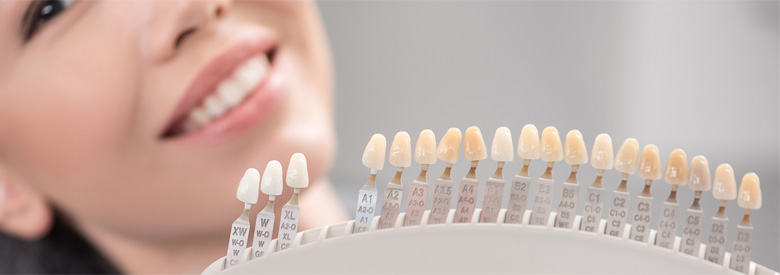
Placement of veneers is largely similar to placement of crowns onto healthy teeth. First, a model of the tooth is made by way of impression or a 3D scan, then, the teeth are recontoured, normally not deeper than 0.3 mm per tooth and then a patient gets temporary veneers until permanent ones are fabricated. In case of no-prep veneers or composite veneers, there is no interim period requiring temporary veneers, but the patient gets the final veneers straight away if they are composite, or goes home after taking impressions and then comes for the placement of no-prep veneers once they are done. Veneers are cemented onto teeth (or are applied in layers if composite) and a patient can have fully functioning teeth practically straight after the placement.
Veneer placement is essentially a process of placing a cover over the front side of teeth which has a superior shape and colour, and this is why it is very important to plan in detail the shape, alignment and colour of each veneer.
As soon as after the first appointment it is necessary to make, in discussion with the patient, a detailed treatment plan, which will bring together the wishes of the patient and the realistic outcomes of the procedure.
It is not unusual to use fixed braces as a preparation for veneers in order to align teeth before placement, because although veneers can partly improve issues with the alignment, only braces can straighten major irregularities. Even if a patient later decides not to go for veneers, wearing braces is always a good idea that enhances appearance of your teeth.
Specialists at our clinic have a lot of experience in creating ceramic veneers using CAD/CAM dentistry (computer-aided design and computer-aided manufacturing) on a CEREC machine which provides perfect precision, supreme esthetic outcome and the completion of a product within only an hour.
DSD provides software modeling for the future smile and designs models of temporary veneers which serve as the base for fabricating the final ceramic veneers. Although this technology is superior to handmade modeling, our experience has shown that computer assisted design cannot be 100% reliable because there is a great number of steps when importing DSD models and there may be minor inconsistencies.
Once a patient is happy with the presented shape and position of teeth, temporary crowns are scanned and final veneers are fabricated using these crowns. Upon this, teeth are prepared for recontouring if necessary. If not, the no-prep veneers are used. Once the teeth are ready, they are scanned using CEREC OMNI CAM and then the veneers are modeled using software. After this, the CEREC MCXL machine for fabricating dental appendages is used to make veneers.
Cementing is quite a simple process, and without the latest adhesives, which we call cement in everyday use (although they don’t possess any resembles to standard cement), veneers procedures would be impossible to accomplish, because, unlike fillings and crowns, veneers require adhesive to bond with teeth. There is more likelihood that a veneer will fracture rather than fall off, although any kind of damage to veneers is highly unlikely to begin with, and the longevity of veneers is affected more by the condition of teeth than the mechanical damage of veneers. This also means that once a veneer is placed, it is impossible to remove it, although this is only considered in theory, since we have never had a patient wishing to take their veneers off.
How is it possible that the cement is so reliable? The trick is in the tooth itself. It is highly recommended that during contouring we do not go further than enamel. This layer of tooth is very thin and must be minimally recontoured, so as to make the bond between the veneer and the tooth stronger. When a veneer and a tooth are bonded over enamel using cement, the resulting bond is the strongest and the most long-lasting, which is corroborated by numerous studies. Cementing takes next to no time, and a patient may continue their everyday activities straight away.
Just cemented veneers
